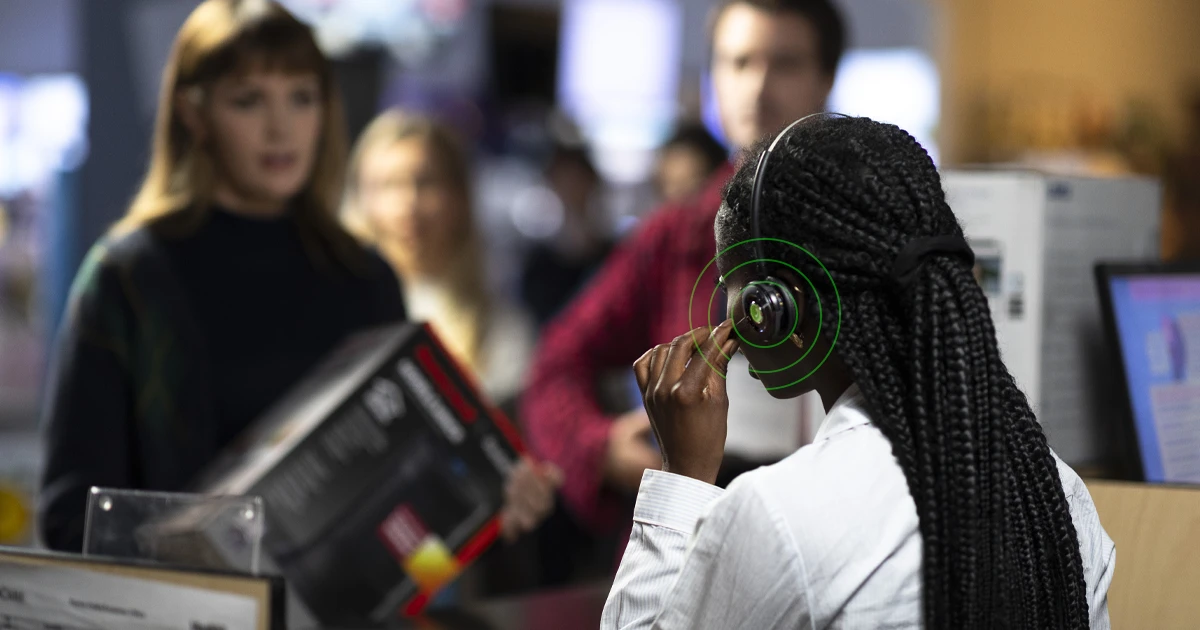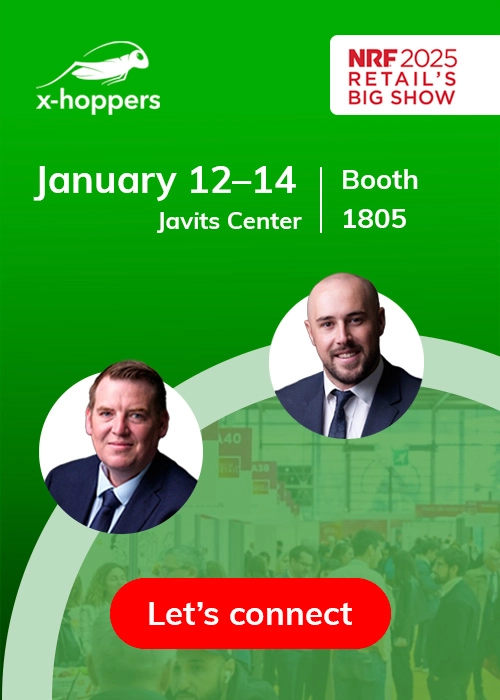
At the end of the holiday season, how often do you think to yourself, “I’m definitely going to be better prepared for next year,” only to suddenly hit peak season with the same plan that failed you the year before?
Well, it’s time things finally changed. Despite the heat making Christmas seem ages away, now is the perfect time to pause, assess your seasonal retail challenges and start to put in place real, sustainable changes that will make a difference to you — and your team — through peak season and beyond.
What are the biggest seasonal retail challenges?
Holiday sales in the last two months of the year make up an average of 19% of a store’s yearly earnings, with some reaching as high as 30%, according to the National Retail Federation. With so much riding on this peak period, overcoming any sales barriers is absolutely essential for success.
Since it’s been half a year since the holiday season wound down, let’s refresh your memory by taking a closer look at the most common issues retailers face and some strategies for how you can enter the golden quarter with unseasonal calmness and clarity.
Setting up and tracking seasonal displays
Even if you’ve ordered all your promotional and seasonal items well in advance, there’s always a risk that delivery issues or other unexpected events will require last-minute adjustments. Here, fast, efficient communication is key. That’s why, first and foremost, you should take a close, hard look at your internal communications and ask yourself the following questions:
- How many different channels are you using to share important, actionable updates?
- How much feedback or information do you have on the shop floor?
- Is something like a product recall easy and quick to share across your store estate?
- Where are the communication bottlenecks?
When it comes to technology you can use to address these issues, you are spoiled for choice when it comes to in‑store communications, from app‑based solutions on personal devices to discreet wearable solutions, such as x‑hoppers. The trick is to find a solution that doesn’t just solve your person-to-person communication issues, but also can scale with your business and connect your store associates to the wider store — and business — ecosystem.
For example, x‑hoppers’s push-to-talk headsets make it easy for associates and managers to speak quickly and discreetly to each other regardless of where they are in the store, saving precious time and providing seamless service to customers even during seasonal prep. It can also send messages from head office to multiple stores, instantly allowing you to update everyone at once and stay on top of any last‑minute changes.
With tech like this, prepping the store is easier as staff can quickly:
- Make price changes
- Remove recalled products
- Adjust displays
- Call for support
- Distribute tasks
- Collaborate effortlessly
Additionally, with a solution like x‑hoppers, you can even place QR‑code-based call points anywhere in a store. This means you create and customize new call points on the fly, print them out and add them to seasonal displays without having to invest in additional hardware. With these call points, each time a customer scans them, a notification plays directly into the headset, letting employees know where the customer is and even the product they need help with. This ingenious system helps customers connect with a knowledgeable store associate quickly, reducing wait times and boosting sales.
Interestingly, the flexibility of the QR‑code-based call points means you can also use them in non-customer-facing areas, such as a loading bay. Picture this, a delivery arrives late and your staff are already on the sales floor. But all the driver has to do is scan a QR code by the door and immediately a message goes through the headset, notifying staff that the delivery has arrived, with help appearing just moments later.
But smart call points don’t just serve an immediate function. Over time, each QR code scan also adds valuable retail analytical data that can show you when and where customers are interacting with seasonal products. With this information, you can identify if any displays need rethinking or changing and even predict shopping patterns for the next year, helping you improve your peak season operations over time.
How to train seasonal employees when time is short
There are a few ways you can tackle this problem:
- Hire staff earlier to allow for more in‑depth training
- Assign them to basic tasks only
- Connect them to an AI‑driven in‑store communications solution
Extra footfall and, hopefully, transactions mean that you need more than a skeleton crew to run your stores during the holiday season. However, hiring temporary or seasonal staff creates a knock‑on problem — they need training right as trade is picking up.
Now, even with an extra week or two of training built into your onboarding process, the likelihood that you’ll be able to prepare them for whatever retail peak season decides to throw their way is quite slim. Customers see no difference between experienced associates and fresh recruits and will expect the first employee they see to answer their questions correctly and promptly. So even if you’ve assigned new recruits to replenishment tasks, customers will still approach them.
As a result, we suggest a third way — providing them with an AI‑driven communication system.
Why should you consider AI‑driven communication for training?
While a regular wireless headset communication system can be an invaluable training tool, there’s no built‑in backup if managers or experienced staff members are off. In that case, who can answer questions and help with training? With a communication system featuring an embedded AI assistant, retail training becomes more efficient as new staff members can simply ask a question through the headset, just like they would to speak to a colleague. They then receive a real-time answer over the headset, based on proprietary product or procedural information, ensuring that new starters can quickly access the information they need without ever leaving a customer’s side.
Additionally, if, like with x‑hoppers, the solution also comes with transcription and conversation intelligence, you can quickly analyze what’s been said over the in‑store broadcast and uncover any knowledge gaps or recurring issues, helping you address them quickly to provide the best customer service possible.
How to upskill existing employees for peak demands
While hiring new staff and giving them access to instant support can help with the address pressures that peak brings, you’re not likely to trust seasonal employees with more complicated procedures or responsibilities. But yet they’re still in high demand. Take returns, for example; some retailers have dedicated returns departments, while others only extend this privilege to managers and assistant managers. But when January rolls around and unwanted or ill‑fitting gifts find their way back to the store, you need more people who can process them, or you risk exceedingly long lines and angry customers.
The solution? Upskill your most experienced and trusted employees in the months leading up to peak. You can identify who they are through your direct experience with them, or if you’re already using a communication system with advanced analytics, you can consult real‑time data to help you identify your retail superstars.
With x‑hoppers, for example, each user has a unique sign‑on, so the system can create detailed reports on individual employees, showing you who’s responding to notifications and alerts, how quickly they do so and even the amount of time they talk on the broadcast. Thus, you don’t have to just rely on your gut, but actually make a data-based decision on who would be the best candidate to learn key skills, and perhaps once you survive peak, even be promoted.
Just like with seasonal employees, an AI‑driven headset solution can give experienced associates instant access to procedural guidelines, providing them with additional support once you’ve upgraded their system permissions and offered some practical training. Because no matter how well you prepare them, there’s nothing like a sudden rush to make anyone forget their new skills. But with an AI assistant and instant access to colleague support, they’ll have plenty of ways to get the additional help they need until their new skills finally become second nature.
Deploying staff where they're needed most
Once you have all the staff you need with the right skill levels, the next issue is making sure you have the right people in the right place at the right time.
As easy as that sounds, it’s one of the hardest parts of holiday retail management. But don’t let that discourage you. To start, have a look at any historical data you have, whether on footfall, sales or any other metrics, to ensure that your scheduling is as close to what’s required as humanly possible.
On the day, however, reality can be very different from the plan. Your footfall could be higher, a new promotion may need more detailed explanation or you could have a flood of online returns. Here, a wireless hands-free communication system is worth its weight in gold. Because at the push of a button, you can redeploy your staff around the store or walk them through a query they’ve never come across before. Add in notifications from QR‑code-based call points, self-checkouts, security cameras or other store systems, and you don’t even need to be the one redirecting staff — the system will do it for you! Depending on the solution, you can even set it so that certain notifications only go to specific teams or individuals with the necessary skill set, literally ensuring that the right message gets to the right person at the right time.
And what customer wouldn’t want to shop at a store that consistently delivers the exact help they need, when they need it?
How to provide exemplary customer service during a rush
More than any other time of year, the run‑up to the holidays is your best chance to make a good first impression with new customers. Why? People will go into shops they’ve never even heard of just to find the perfect gift. But if any part of the experience is lacking, it won’t just be their first visit — it’ll also be their last.
Which is why every part of your retail peak season strategy should, at its core, be focused on offering the best possible customer experience. The good news is that if you can successfully tackle the problems earlier, namely display, training and deployment, you’re already halfway to meeting customer expectations.
But you also need to take into consideration that the holidays are hectic and shoppers have more than one item on their to‑do list. To secure sales, you can’t risk leaving them waiting a second longer than they’re prepared to wait. Luckily, call points, whether physical, QR code or tablet-based, can quickly connect customers to the help they need. But what about customers who don’t even have the time to engage with a call point?
Here, computer vision technology can catch desperate shoppers even when your staff are too busy to notice. Trained to recognize when a customer is actively searching for help, waiting for an extended amount of time or even when a line is forming, this technology can automatically push out notifications to either apps or a retail headset system such as x‑hoppers, notifying staff instantly. So, without even having to stop or press a button, a customer can get the help they need to finish their shopping list — and your associates can get closer to their target.
But wireless headsets are more than just notification receivers. They are also the perfect hands and screen-free interface for your staff to access a wealth of information, allowing them to get answers to customer questions without ever having to leave a customer’s side or even break eye contact. Customers can finally interact with an actual knowledgeable and engaged human — something that shopping online will always struggle to deliver.
How to protect your stores during the busiest season
Not only is the golden quarter the busiest time for sales — it’s retail loss prevention peak season too! With so many extra people in stores, associates are often heavily distracted, creating the perfect environment for opportunistic thieves to strike. To combat this, you could up the security level by requiring receipt checks or physically following suspicious customers, but then you’ll also risk driving customers out of your store.
The best way to strike a balance? Encourage your associates to make eye contact and greet as many shoppers as possible. It’s not only a welcoming gesture, but it also subtly lets would‑be thieves know that they’ve been noticed. But don’t just rely on warm welcomes, support your teams by also implementing surveillance technology such as computer-vision-powered AI theft detection that can alert staff to potential threats and/or facial recognition to flag repeat offenders. Connected to a retail headset system, these technologies can not only help catch thieves but also actively prevent theft while ensuring that there are eyes on all parts of the store.
The only catch? This type of technology does take time to adapt to the realities of each store. That means if you want it to be fully up and running from October onwards, you need to seriously consider getting this type of technology into your stores as soon as possible. Otherwise, you won’t get it to reach optimal performance until the crowds have already died down.
Real-time in‑store communication: The key to thriving during peak
Retail is exciting, dynamic and, at times, unpredictable. No amount of preparation will ever guarantee you a perfect peak, yet if there’s one thing that can help you quickly adapt to the realities on the ground, it’s a secure, wireless, real‑time communication solution such as x‑hoppers.
Complete with a secure broadcast channel, system alerts, call point notifications and a powerful AI assistant, x‑hoppers has everything you need to connect your teams to customers and store systems, giving you all the tools you need to provide outstanding customer service even at the busiest time of year.
But regardless of which solution you choose, make sure that above all else you make sure your teams are highly connected come the beginning of the final quarter. Because if your team can instantly collaborate wherever they are in store, you’ll not only survive but thrive during the most wonderful time of the year.
Enjoyed this article and want to dive deeper? Find more tips on surviving Christmas here or speak to a member of our team to discover how x‑hoppers can help you reach your goals this peak season and beyond.



